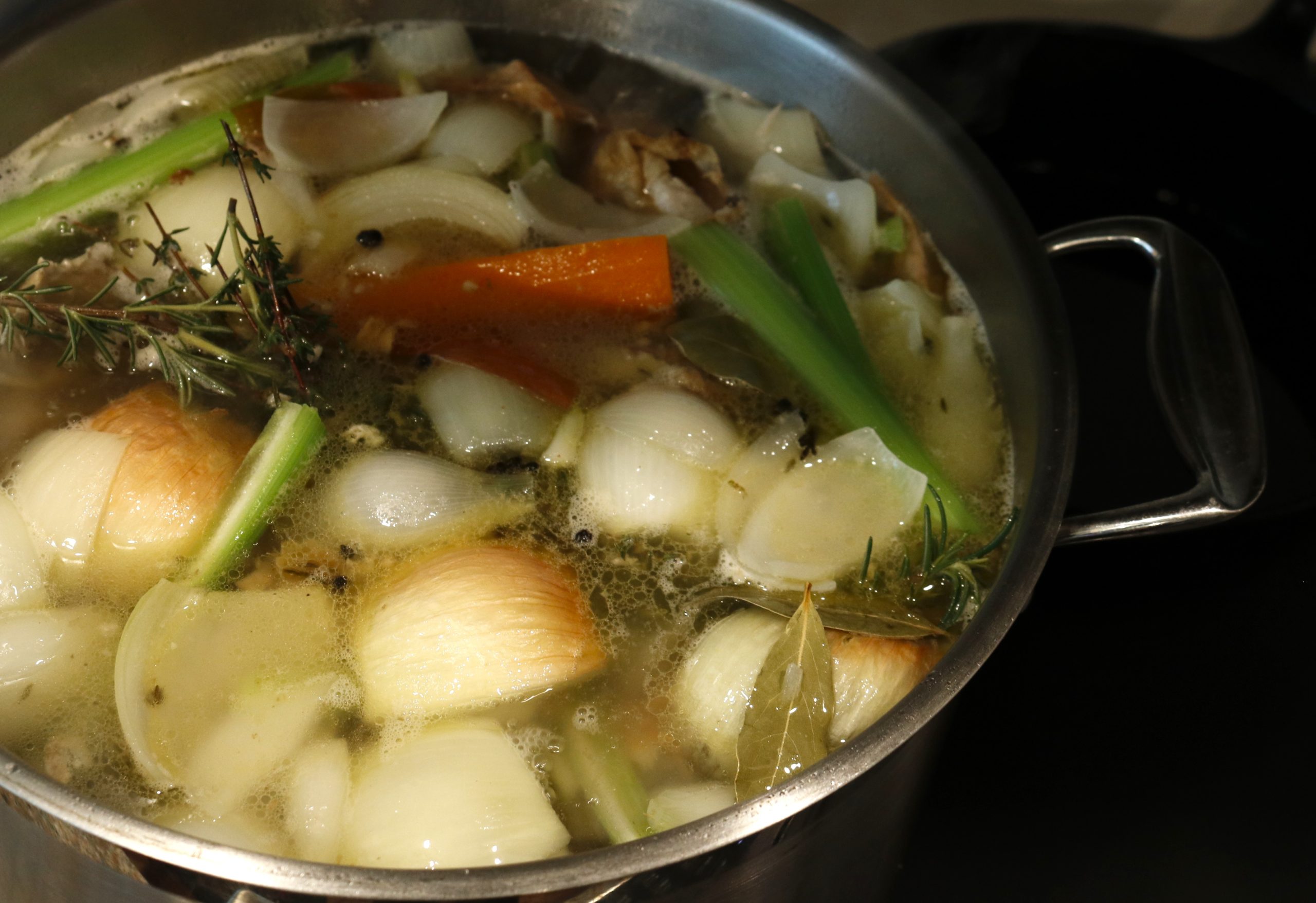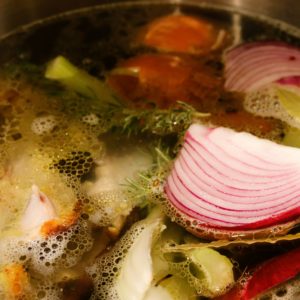
Homemade Chicken Stock
Homemade stock is the backbone to any soup, risotto, braised dish, etc. It has so many more nutrients, better texture and flavor compared to store bought. Chicken stock is not challenging and there is a process to follow to help create delicious stock every time – rinse the bones, fill it to the top with cold water, gently bring water to a simmer, add mirepoix and herbs, and then let it go…..for 6-10 hours, skimming off impurities throughout the process. It’s TIME that you need!
It is common for stock recipes to state only 3-4 hours is necessary to create a decent stock, which is true to a certain extent (Mason, C., & López-Alt, K. J., 2015). According to various professional cooking references, a clear broth is what many professional chef’s are trying to create, but in our house we are going for flavor. We typically simmers our chicken stock for about 8-12 hours and utilize a combination of raw bones and rotisserie chicken bones when possible. For convenience, we make start our stock around 8 pm and then strain it around 6-8 am the following day. I have found that 6-8 hours is optimal and will simmer our stock for that amount of time when I make it on a weekend while we are at home.
To make delicious and nutritious homemade stock, you need bones and LOTS! If we are making something special, we will buy raw chicken bones and feet specifically to extract as much collagen as we can. But most of the time we will save all of our chicken bones when we cook a whole chicken or get a rotisserie chicken from the store; I have a big bag in the freezer that I continuously add to until we are ready to make stock. The collagen in the bones is what creates the flavor and texture of the stock, so load the pot up! My husband always states that if the stock is cool and giggly, we made it right!
Once made, it needs to be strained, I use a regular strainer for the big stuff and then a fine mesh strainer (chinois) to catch the remaining smaller particles, such as a rosemary leave, etc. It can take a little bit of time to do this part if you are making a large amount, but it is worth it. Once strained, portion into whatever containers you plan on storing the stock in and cool using an ice bath. Store in the freezer for up to a month (if it lasts that long).


Tips & Tricks:
- If using raw bones, rinse the bones, feet, necks, etc. with cold water to remove any visible blood or other impurities that can contribute an odd flavor.
- If using cooked bones, don’t worry about rinsing them.
- Place bones in the pot – bones, feet, necks, skin, juices, etc.
- Fill with COLD water – using cold water speeds extraction; starting with hot water delays extraction because certain proteins are soluble in cold water but not in hot water (Gisslen, 2008).
- Slowly bring water to a simmer, not a boil because this can break up solids into tiny particles and result in a cloudy stock (Keller, 1999).
- Add onions, carrots, celery, and herbs.
- Skim off impurities that rise to the surface of the stock often – it can look like a odd foam.
- Simmer for minimum 12 hours.
- Our chicken stock is typically simmered for 12-14 hours for the best flavor.
- Always keep the water level above the bones and continue to add water if needed – I sometimes add water 2-3x during the process.
- If the water reduces and the bones are not fully covered, you will end up cooking the bones instead of extracting flavor (Gisslen, 2008).
- Use a large strainer to remove majority of the large pieces, then pour stock through fine mesh strainer, such as a chinois.
- Cool the stock as quickly as possible using an ice bath before storing.
- Freeze in mason jars or plastic bags for up to 3 months in a deep freezer.
- If using mason jars to freeze – do not fill to the top, fill about 3/4 full; you want to allow for the contents to freeze and expand. (I have broken so many jars by accidently filling it to much).
Equipment:
- Large pot
- Knife
- Cutting board
- Large strainer
- Fine mesh strainer – chinois
- Large bowls
- Mason jars**/Plastic bags to store


Chicken Stock
Ingredients
- 3-5 chicken bone, skin, juices (if using leftovers) bones cut up
- 1 lb chicken feet (optional)
- 2-3 yellow onions quartered
- 3-4 carrots cut in half
- 3-4 celery stocks cut in half
- handful fresh rosemary
- handful fresh thyme
- 4-5 sage leaves (optional)
- handful whole peppercorns
- 2-3 bay leaves
- cold water fill to 1 inch below the lip of the stock pot
Instructions
- Cut onions into quarters, carrots and celery in half. Set aside.(If using uncooked bones, rinse chicken bones and feet to remove any impurities.)
- Place bones, skin, juices, and feet in large stock pot.
- Fill stock pot with cold water until about 1-inch from the top.
- Slowly heat water to a gentle simmer and skim the top to remove any impurities.
- Add onions, carrots, celery, and herbs.
- Continue to skim to remove any impurities that float to the top of the water often.
- Let simmer for 12-16 hours.
- Once stock is done, use a large strainer to remove the larger bits – chicken bones, onion, etc.Then once the big pieces have been removed, strain through a fine mesh strainer, such as a chinois.
- Portion into whatever containers for storage, it recommended to cool liquid quickly using an ice bath before freezing or storing in fridge.
Notes:
- Stock will remain good in the fridge for 1-2 days, or in the freezer for longer storage.
- If you use mason jars in the freezer – only fill ¾ of the way full (just below the curve of the top of the jar) or the jar may break when the stock freezes. I have done this too many times to count!
Notes
YOUR RISK OF FOODBORNE ILLNESS, ESPECIALLY IF YOU HAVE CERTAIN MEDICAL CONDITIONS.
References:
Mason, C., & López-Alt, K. J. (2015). The Food Lab: Better Home Cooking Through Science (Illustrated). W. W. Norton & Company.
Gisslen, W. (2008). Professional Baking, 5th Edition (5th ed.). John Wiley and Sons.
Keller, T. (1999). The French Laundry Cookbook. Artisan.
